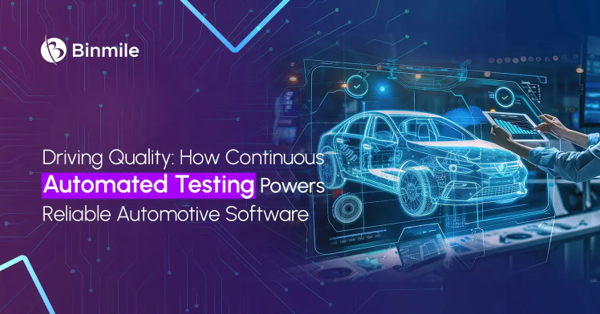How Continuous Automated Testing Powers Reliable Automotive Software
In today’s automotive industry, reliability and quality are paramount. Continuous automated testing has emerged as a critical process in ensuring the robustness of automotive software. Let’s explore how continuous automated testing powers reliable automotive software and why it’s essential for the industry.
Understanding Automated Testing for Automotive Software
Automated testing involves the use of specialized software tools to execute tests and compare actual outcomes with expected results automatically. In the automotive sector, automated testing is crucial for validating software components and systems.
Specifics of Testing Automotive Software
Automotive software differs from conventional software due to its complexity and criticality. It includes components for vehicle control, safety systems, infotainment, and more, all of which must function flawlessly.
Importance of Quality Assurance in Automotive Industry
Quality assurance is vital in the automotive industry to ensure the safety and reliability of vehicles. Any software malfunction or defect can have severe consequences, making thorough testing indispensable.
Challenges in Automotive Software Development
Complexity of Automotive Systems
Modern vehicles feature complex software architectures with numerous interconnected components, increasing the difficulty of testing.
Safety and Regulatory Compliance
Automotive software must comply with stringent safety standards and regulations, requiring extensive testing to ensure compliance.
Rapid Development Cycles
The automotive industry operates on tight development timelines, necessitating efficient testing processes to meet deadlines without compromising quality.
Continuous Automated Testing Process
Test Planning and Design
The testing process begins with comprehensive test planning and design, including defining test scenarios and criteria.
Test Execution
Automated tests are executed systematically, with software tools simulating various scenarios and evaluating outcomes.
Test Reporting and Analysis
Test results are analyzed to identify defects and areas for improvement, enabling developers to refine software iteratively.
Benefits of Continuous Automated Testing
Early Detection of Bugs and Issues
Automated testing enables early detection of bugs and issues, preventing them from escalating into more significant problems later in the development cycle.
Faster Time to Market
By streamlining the testing process, continuous automated testing accelerates the development cycle, allowing manufacturers to bring products to market more quickly.
Improved Product Quality and Reliability
Thorough testing enhances the quality and reliability of automotive software, reducing the likelihood of malfunctions and recalls.
Key Features of Automated Testing Tools for Automotive Software
Support for Complex Test Scenarios
Automated testing tools for automotive software offer advanced capabilities to simulate complex scenarios and conditions encountered on the road.
Integration with Development Tools
These tools seamlessly integrate with development environments, allowing for efficient collaboration between developers and testers.
Compliance with Automotive Standards
Automated testing tools adhere to automotive industry standards and regulations, ensuring that software meets safety and quality requirements.
Real-World Examples of Continuous Automated Testing in Automotive Industry
Case Study 1: Leading Automotive Manufacturer
Company X implemented continuous automated testing to validate software components for its latest vehicle models, resulting in improved reliability and customer satisfaction.
Case Study 2: Automotive Software Development Firm
Firm Y specializes in developing software solutions for autonomous vehicles and relies on continuous automated testing to verify system performance and safety.
Choosing the Right Automated Testing Tools
Criteria for Selection
When choosing automated testing tools, consider factors such as ease of use, scalability, and compatibility with existing systems.
Considerations for Automotive Software Development
Select tools specifically designed for automotive software testing, with features tailored to address industry-specific challenges.
Best Practices for Implementing Continuous Automated Testing
Establishing Clear Testing Objectives
Define clear objectives and metrics for testing to ensure that all stakeholders understand the goals and expectations.
Integrating Testing into Development Process
Integrate testing seamlessly into the development process to identify and address issues early in the lifecycle.
Regular Maintenance and Updates of Testing Infrastructure
Maintain and update testing infrastructure regularly to ensure optimal performance and reliability.
Role of Custom Software Development Services in Automotive Testing
Tailored Solutions for Specific Needs
Custom software development services offer tailored solutions to meet the unique testing requirements of automotive manufacturers.
Expertise in Automotive Industry Standards
These services have expertise in automotive industry standards and regulations, ensuring compliance and adherence to best practices.
Seamless Integration with Existing Systems
Custom solutions seamlessly integrate with existing development and testing systems, minimizing disruption and maximizing efficiency.
Future Trends in Continuous Automated Testing for Automotive Software
AI and Machine Learning in Testing
AI and machine learning technologies will play a significant role in enhancing testing capabilities, enabling predictive analysis and anomaly detection.
IoT Integration for Real-Time Monitoring
Integration with IoT devices will enable real-time monitoring of vehicles and systems, allowing for proactive maintenance and troubleshooting.
Advanced Simulation and Modeling Techniques
Advanced simulation and modeling techniques will enable more accurate and realistic testing scenarios, improving the reliability of test results.
Challenges and Considerations for Future Development
Security and Data Privacy Concerns
As automotive software becomes more connected, ensuring security and data privacy will be paramount to protect against cyber threats.
Scalability of Testing Infrastructure
Scalability will be a challenge as the volume of automotive software increases. Testing infrastructure must be able to scale to accommodate growing demands without sacrificing performance.
Keeping Pace with Technological Advancements
Continuous innovation in automotive technology presents challenges in keeping testing methodologies and tools up-to-date to address evolving requirements.
Conclusion
Continuous automated testing is indispensable for ensuring the reliability, safety, and quality of automotive software. By embracing automated testing processes and leveraging advanced tools and technologies, manufacturers can meet the demands of an ever-evolving industry while delivering products that meet the highest standards of performance and safety.
Frequently Asked Questions
1. What is continuous automated testing?
Continuous automated testing involves the use of automated software tools to execute tests and evaluate outcomes continuously throughout the development process.
2. Why is automated testing important in the automotive industry?
Automated testing is crucial in the automotive industry to ensure the reliability, safety, and quality of vehicle software, which directly impacts driver and passenger safety.
3. What are some challenges in automotive software development?
Challenges in automotive software development include the complexity of automotive systems, stringent safety and regulatory requirements, and rapid development cycles.
4. How do automated testing tools benefit automotive manufacturers?
Automated testing tools enable automotive manufacturers to detect bugs and issues early in the development process, accelerate time to market, and improve product quality and reliability.
5. What role do custom software development services play in automotive testing?
Custom software development services provide tailored solutions to meet the unique testing requirements of automotive manufacturers, ensuring compliance with industry standards and seamless integration with existing systems.





